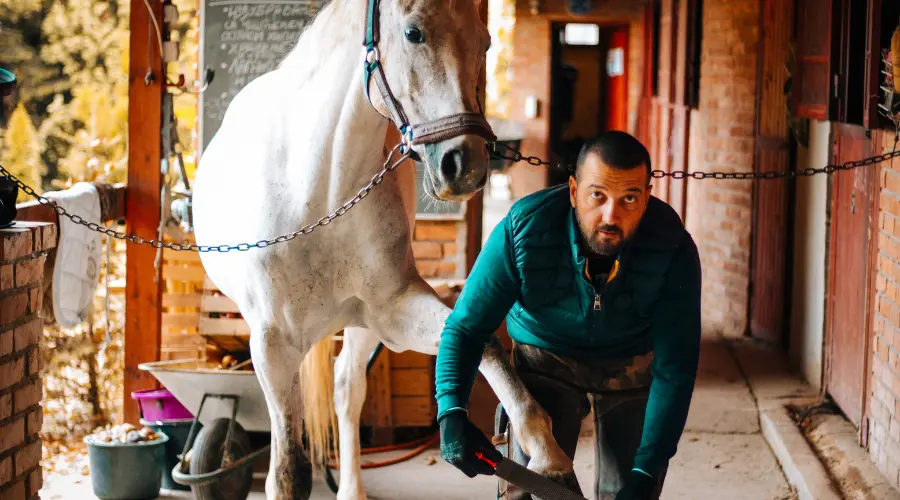Is it normal for a horse to bleed after trimming? Have you experienced this problem with your horse? If yes, you probably want to know the causes and how to prevent the bleeding.
Trimming overgrown hooves is an essential step in the horse care routine. Normally, the trimming process is pain-free for your horse as the horse’s hoof doesn’t have nerve endings. What if you notice your horse’s hoof is bleeding after a trim?
What does this mean for you?
Well, in most cases, hoof bleeding after trim means your farrier trimmed the hooves way too short until he/she got to the blood. We will dig deeper into this issue and find the right preventive measure for bleeding after hoof trimming.
Let’s jump in!
What are the causes of hoof bleeding? is it normal?
There are many possible causes of hoof bleeding.
But is it normal? Of course not! Since hooves do not have nerves or blood vessels, bleeding is not normal, and this should alert you there is a problem with your horse’s foot.
The sole and the rear part of the hoof get their blood supply from the arteries. Injuring the blood vessels is common because of where they are located. When these vessels are cut, severe bleeding takes place.
Do you want to know what causes hoof bleeding, let me explain!
Excessive trimming
When you hire an inexperienced hoof trimmer to trim your horse’s hooves, they can most likely lead to over-trimming. Whether the farrier is using a hoof knife or a nipper for trimming the sole and frog, he should be careful to prevent cutting either of them.
Trimming the hooves too short can lead to bleeding and exposure to sensitive tissues. Even if they are dealing with hoof rot, excessive trimming has adverse effects on hoof health, and it is a possible cause of hoof bleeding.
Sharp objects
Noticing bruises on the sole can take weeks or months. In instances where your horse has gone through some trauma from a sharp stone, rocky ground, glass pieces, wood splinters, or needles, puncture wounds can take place leading to bleeding.
Ruptured blood vessels
When the horse’s foot has some small ruptured blood vessels, bleeding can take place in the soft tissues.
Related article: When it comes to horse hooves, iodine can be a helpful tool in the hardening process.
How do you stop a horse’s foot from bleeding?
Horse owners should know how to handle emergencies when their horse is hurt. Knowing how to handle the injuries right and stop the bleeding can be life-saving.
Regardless of the cause of the bleeding, the first thing to do is to prevent more blood loss. Of course, you need to call a vet but before he arrives, do smoothing to prevent the bleeding. Otherwise, you might risk losing your horse if the bleeding is too much.
Here is what you should do!
Use an absorbent material and apply first and direct pressure on the wound for about 5 minutes. Do not remove the absorbent material from the wound even if it soaks with blood. Add an extra layer and keep applying pressure until your vet arrives.
Related: A complete guide to horse hoof trimming tools and uses. Learn all you need to know about the best tools, their benefits, and how to use them correctly.
What to do if your horse’s hoof bleeds?
What steps should you take when your horse’s hoof is bleeding? When your horse has a cut or a wound, the first thing a horse owner should do is stop the bleeding. How do you do this?
Let me show you how!
Use a clean piece of cotton to apply pressure on the cut. You can choose to hold or bandage the cut until there is no more bleeding or when your vet comes.
If the bleeding was a result of too much trimming, wrap the horse’s hoof in a diaper and duct tape to keep it clean. When the bleeding has stopped, and your horse is calm, check the rest of the hoof. This will help you determine whether the sole is too thin.
And it doesn’t stop there!
The bleeding can also result from a cut vein or artery. In such cases, it can take between 20 minutes and an hour for the cut to stop bleeding. Some artery bleeding only requires a vet to tie it off. You should only apply pressure until the vet arrives.

Tips for wound care & cleanliness
Immediately you realize your horse has a wound, and it is bleeding, these tips are great for wound care and cleanliness.
- Stop the bleeding by applying pressure for about 20 minutes;
- When bleeding stops, check the severity of the wound;
- Clean the wound to minimize risks of getting infections;
- You or your vet should treat the wound;
- Keep checking your horse for complications when the wound is healing;
See also: If you’re wondering whether Keratex or Durasole is better for your horse, look no further!
Conclusion
Hoof bleeding in horses can result from cuts, and wounds among other different causes. By now, I believe you understand the causes of hoof bleeding and what you can do to stop it. For minor bleeding, you can give your horse first aid to prevent bleeding.
However, severe bleeding needs your vet’s attention. To prevent bleeding from hoof trimming, ensure you hire a professional trimmer to trim your horse’s overgrown hooves. He should understand your horse’s hoof anatomy as well as how to do the procedure correctly.



